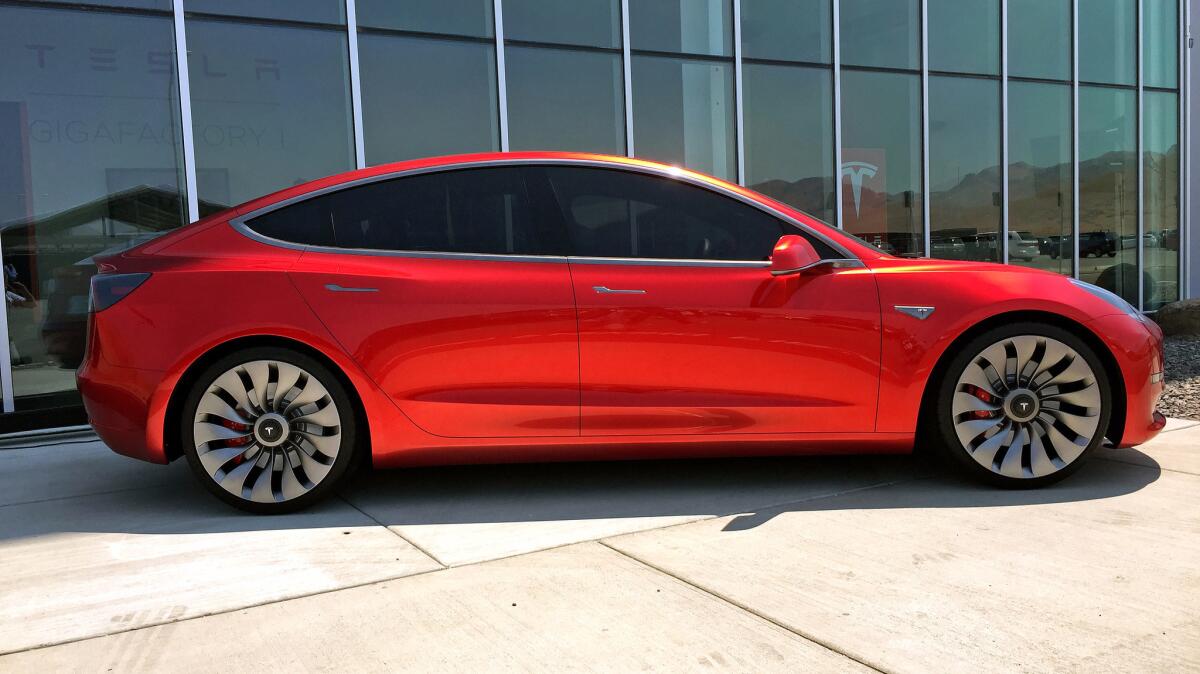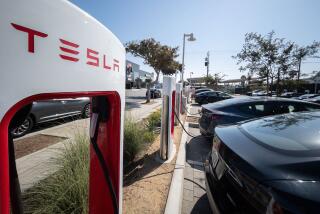With Model 3 orders looming, Tesla seeks approval to double size of Fremont factory

Tesla Motors Inc. took a major step toward its ambitious goal of one day building 1 million cars a year by seeking to double the size of its Fremont, Calif., assembly plant.
Under a long-term zoning proposal submitted to Fremont’s Planning Commission, the electric car maker wants to eventually add 4.6 million square feet of space to its factory’s existing 4.5 million square feet.
Tesla currently produces its luxury Model S sedan and Model X sport utility vehicle at the plant and next year plans to start building its mid-priced Model 3 sedan that’s aimed at drawing a wider following among car buyers.
Chief Executive Elon Musk told analysts this spring that the Palo Alto-based automaker hopes to ramp up annual production to 500,000 vehicles in 2018 and build 1 million vehicles by the end of 2020.
The 2018 goal alone is nearly a tenfold increase from the 50,580 vehicles that Tesla produced last year in Fremont. The automaker has forecast this year’s deliveries at 80,000 to 90,000.
Quality problems and production delays plagued the plant early this year and threatened sales plans. But the company said last week that those problems are behind it and that it expects to come close to its forecast for 2016.
The pressure is now on Tesla for a smooth launch of the relatively affordable Model 3. A quality product pumped out at low cost and high volume is essential to meeting the ambitious goals of the company and its investors, auto analysts say, whereas long delays could threaten the company’s reputation — and survival.
Customers of cutting-edge high-end automobiles like the Model S and Model X tend to forgive small quality glitches, but near-perfect quality is a top concern for mid-market buyers, meaning there’s little wiggle room as Tesla dramatically expands the Fremont plant and its business model.
As part of the expansion, Tesla purchased a 25-acre lot just north of the factory, according to a staff assessment of Tesla’s plan placed on the Planning Commission’s website last week.
Tesla employs 6,210 workers at the plant, and city planning officials estimate another 3,105 jobs could be added with the expansion.
The commission is scheduled to discuss the issue Thursday. The planning staff recommended that the commission and Fremont City Council approve the proposal.
Tesla declined to comment on the plan’s specifics or timeline but said Monday that “we are pleased to work with the city of Fremont on a plan that reaffirms our commitment to California and to eventually maximize the potential of our Fremont factory site.”
The factory, which sits off Interstate 880 northeast of San Jose, was built in 1962 as a General Motors Co. plant.
Later it became the site of a production joint venture between GM and Toyota Motor Corp. called New United Motor Manufacturing Inc., or NUMMI. But that operation closed in 2010 after the financial crisis. Tesla started building cars there in 2012.
“This site offers Tesla opportunities for transit-connected growth, which is great for Fremont and the region,” said Kelly Kline, Fremont’s economic development director. “It’s a commitment to advanced manufacturing in California, which is seeing a great resurgence.”
Kline said the economic spinoff of manufacturing is “tremendous,” with other companies in the supply chain choosing to cluster near Tesla.
The Fremont planning officials estimated that doubling the size of Tesla’s plant would allow for building up to 500,000 vehicles a year. It’s unclear whether the site could handle more production than that as Tesla tries to get to 1 million vehicles a year.
“I think it is actually feasible, maybe not advisable, but feasible to do it with just Fremont and the Gigafactory,” Tesla’s battery factory in Nevada, Musk told the analysts in May.
“We actually believe that Fremont and the Gigafactory could scale to a million vehicles,” he said. “Whether that’s actually wise is a separate question.
“It’s going to make sense to do localized production at least on a continent basis,” Musk said. “Otherwise your logistics costs end up being quite extreme.”
As Tesla ramps up to produce its highest-volume car yet, some analysts questioned whether the company — which has fallen short of production targets in the past — could meet its latest goals, even with the added space.
“It’s going to take them some time to get those volume targets,” said Ed Kim, vice president of industry analysis at AutoPacific. “I think it’s going to take longer than they’ve said so far.”
While speed to market is a concern, so is quality.
Unlike Tesla’s early adopter customers, Model 3 customers will be more demanding because the vehicle is likely to be their only car, Kim said.
“The bigger goal needs to be to get the quality right,” he said. “Focus on quality over quantity, at least initially, because these are not going to be as forgiving a customer as their Model X and Model S customer.”
Meanwhile, Musk tried to alleviate some of the financial concerns surrounding Tesla’s plan to acquire publicly held SolarCity Corp., a provider of solar-power panels, for $2.6 billion in Tesla stock. Critics contend both companies already have cash-flow problems that could be exacerbated by the transaction.
Musk, who is SolarCity’s chairman and largest shareholder, said Sunday on Twitter that the companies would not need to ask the financial markets for more money in the current quarter.
“Would also like to correct expectations that Tesla/SolarCity will need to raise equity or corp [sic] debt in Q4,” Musk tweeted. “Won’t be necessary for either.”
But Efraim Levy, an analyst with CFRA Research, said Tesla’s recent filings with securities regulators “bolster our projections that TSLA will need to raise cash to support the deal.” Levy reiterated his “sell” recommendation on Tesla’s stock.
Tesla’s stock gained $4.34, or 2.2%, to $200.95 on Monday while SolarCity’s stock jumped 91 cents, or nearly 5%, to $19.59.
Karl Brauer, executive publisher of Kelley Blue Book, said the factory expansion will be another “big challenge,” in addition to combining Tesla and SolarCity and getting the Gigafactory up and running.
“It’s another big item on a daunting to-do list for Elon in the next 12 to 24 months,” he said. “He’s got the physical space to make the factory much larger. But that’s the easiest part of the process.”
And he, too, was skeptical of the vehicle targets.
“You need to produce a lot of cars per day, per hour, and everything has to be kind of perfect or close to it to hit those kinds of numbers,” Brauer said. “That seems hard to imagine in the next two years.”
Times staff writer Russ Mitchell in San Francisco contributed to this report.
For more business news, follow James F. Peltz on Twitter: @PeltzLATimes
ALSO
Millennials aren’t big spenders or risk-takers, and that’s going to reshape the economy
Hospitals in California would have to report superbug infections under planned legislation
Despite exploding smartphones, customers are likely to stick with Samsung








